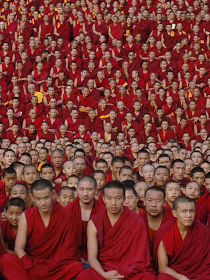- Home
- FPMT Homepage
Foundation for the Preservation of the Mahayana Tradition
The FPMT is an organization devoted to preserving and spreading Mahayana Buddhism worldwide by creating opportunities to listen, reflect, meditate, practice and actualize the unmistaken teachings of the Buddha and based on that experience spreading the Dharma to sentient beings. We provide integrated education through which people’s minds and hearts can be transformed into their highest potential for the benefit of others, inspired by an attitude of universal responsibility and service. We are committed to creating harmonious environments and helping all beings develop their full potential of infinite wisdom and compassion. Our organization is based on the Buddhist tradition of Lama Tsongkhapa of Tibet as taught to us by our founders Lama Thubten Yeshe and Lama Thubten Zopa Rinpoche.
- Willkommen
Die Stiftung zur Erhaltung der Mahayana Tradition (FPMT) ist eine Organisation, die sich weltweit für die Erhaltung und Verbreitung des Mahayana-Buddhismus einsetzt, indem sie Möglichkeiten schafft, den makellosen Lehren des Buddha zuzuhören, über sie zur reflektieren und zu meditieren und auf der Grundlage dieser Erfahrung das Dharma unter den Lebewesen zu verbreiten.
Wir bieten integrierte Schulungswege an, durch denen der Geist und das Herz der Menschen in ihr höchstes Potential verwandelt werden zum Wohl der anderen – inspiriert durch eine Haltung der universellen Verantwortung und dem Wunsch zu dienen. Wir haben uns verpflichtet, harmonische Umgebungen zu schaffen und allen Wesen zu helfen, ihr volles Potenzial unendlicher Weisheit und grenzenlosen Mitgefühls zu verwirklichen.
Unsere Organisation basiert auf der buddhistischen Tradition von Lama Tsongkhapa von Tibet, so wie sie uns von unseren Gründern Lama Thubten Yeshe und Lama Thubten Zopa Rinpoche gelehrt wird.
- Bienvenidos
La Fundación para la preservación de la tradición Mahayana (FPMT) es una organización que se dedica a preservar y difundir el budismo Mahayana en todo el mundo, creando oportunidades para escuchar, reflexionar, meditar, practicar y actualizar las enseñanzas inconfundibles de Buda y en base a esa experiencia difundir el Dharma a los seres.
Proporcionamos una educación integrada a través de la cual las mentes y los corazones de las personas se pueden transformar en su mayor potencial para el beneficio de los demás, inspirados por una actitud de responsabilidad y servicio universales. Estamos comprometidos a crear ambientes armoniosos y ayudar a todos los seres a desarrollar todo su potencial de infinita sabiduría y compasión.
Nuestra organización se basa en la tradición budista de Lama Tsongkhapa del Tíbet como nos lo enseñaron nuestros fundadores Lama Thubten Yeshe y Lama Zopa Rinpoche.
A continuación puede ver una lista de los centros y sus páginas web en su lengua preferida.
- Bienvenue
L’organisation de la FPMT a pour vocation la préservation et la diffusion du bouddhisme du mahayana dans le monde entier. Elle offre l’opportunité d’écouter, de réfléchir, de méditer, de pratiquer et de réaliser les enseignements excellents du Bouddha, pour ensuite transmettre le Dharma à tous les êtres. Nous proposons une formation intégrée grâce à laquelle le cœur et l’esprit de chacun peuvent accomplir leur potentiel le plus élevé pour le bien d’autrui, inspirés par le sens du service et une responsabilité universelle. Nous nous engageons à créer un environnement harmonieux et à aider tous les êtres à épanouir leur potentiel illimité de compassion et de sagesse. Notre organisation s’appuie sur la tradition guéloukpa de Lama Tsongkhapa du Tibet, telle qu’elle a été enseignée par nos fondateurs Lama Thoubtèn Yéshé et Lama Zopa Rinpoché.
Visitez le site de notre Editions Mahayana pour les traductions, conseils et nouvelles du Bureau international en français.
Voici une liste de centres et de leurs sites dans votre langue préférée
- Benvenuto
L’FPMT è un organizzazione il cui scopo è preservare e diffondere il Buddhismo Mahayana nel mondo, creando occasioni di ascolto, riflessione, meditazione e pratica dei perfetti insegnamenti del Buddha, al fine di attualizzare e diffondere il Dharma fra tutti gli esseri senzienti.
Offriamo un’educazione integrata, che può trasformare la mente e i cuori delle persone nel loro massimo potenziale, per il beneficio di tutti gli esseri, ispirati da un’attitudine di responsabilità universale e di servizio.
Il nostro obiettivo è quello di creare contesti armoniosi e aiutare tutti gli esseri a sviluppare in modo completo le proprie potenzialità di infinita saggezza e compassione.
La nostra organizzazione si basa sulla tradizione buddhista di Lama Tsongkhapa del Tibet, così come ci è stata insegnata dai nostri fondatori Lama Thubten Yeshe e Lama Zopa Rinpoche.
Di seguito potete trovare un elenco dei centri e dei loro siti nella lingua da voi prescelta.
- 欢迎 / 歡迎
简体中文
“护持大乘法脉基金会”( 英文简称:FPMT。全名:Foundation for the Preservation of the Mahayana Tradition) 是一个致力于护持和弘扬大乘佛法的国际佛教组织。我们提供听闻,思维,禅修,修行和实证佛陀无误教法的机会,以便让一切众生都能够享受佛法的指引和滋润。
我们全力创造和谐融洽的环境, 为人们提供解行并重的完整佛法教育,以便启发内在的环宇悲心及责任心,并开发内心所蕴藏的巨大潜能 — 无限的智慧与悲心 — 以便利益和服务一切有情。
FPMT的创办人是图腾耶喜喇嘛和喇嘛梭巴仁波切。我们所修习的是由两位上师所教导的,西藏喀巴大师的佛法传承。
繁體中文
護持大乘法脈基金會”( 英文簡稱:FPMT。全名:Found
ation for the Preservation of the Mahayana Tradition ) 是一個致力於護持和弘揚大乘佛法的國際佛教組織。我們提供聽聞, 思維,禪修,修行和實證佛陀無誤教法的機會,以便讓一切眾生都能 夠享受佛法的指引和滋潤。 我們全力創造和諧融洽的環境,
為人們提供解行並重的完整佛法教育,以便啟發內在的環宇悲心及責 任心,並開發內心所蘊藏的巨大潛能 — 無限的智慧與悲心 – – 以便利益和服務一切有情。 FPMT的創辦人是圖騰耶喜喇嘛和喇嘛梭巴仁波切。
我們所修習的是由兩位上師所教導的,西藏喀巴大師的佛法傳承。 察看道场信息:
- FPMT Homepage
- News/Media
-
- Study & Practice
-
-
- About FPMT Education Services
- Latest News
- Programs
- New to Buddhism?
- Buddhist Mind Science: Activating Your Potential
- Heart Advice for Death and Dying
- Discovering Buddhism
- Living in the Path
- Exploring Buddhism
- FPMT Basic Program
- FPMT Masters Program
- FPMT In-Depth Meditation Training
- Maitripa College
- Lotsawa Rinchen Zangpo Translator Program
- Universal Education for Compassion & Wisdom
- Online Learning Center
-
- Prayers & Practice Materials
- Overview of Prayers & Practices
- Full Catalogue of Prayers & Practice Materials
- Explore Popular Topics
- Benefiting Animals
- Chenrezig Resources
- Death & Dying Resources
- Lama Chopa (Guru Puja)
- Lama Zopa Rinpoche: Compendium of Precious Instructions
- Lama Zopa Rinpoche: Life Practice Advice
- Lama Zopa Rinpoche Practice Series
- Lamrim Resources
- Mantras
- Prayer Book Updates
- Purification Practices
- Sutras
- Thought Transformation (Lojong)
- Audio Materials
- Dharma Dates - Tibetan Calendar
- Translation Services
- Publishing Services
- Ways to Offer Support
- Prayers & Practice Materials
-
- Teachings and Advice
- Find Teachings and Advice
- Lama Zopa Rinpoche Advice Page
- Lama Zopa Rinpoche: Compendium of Precious Instructions
- Lama Zopa Rinpoche Video Teachings
- ༧སྐྱབས་རྗེ་བཟོད་པ་རིན་པོ་ཆེ་མཆོག་ནས་སྩལ་བའི་བཀའ་སློབ་བརྙན་འཕྲིན།
- Podcasts
- Lama Yeshe Wisdom Archive
- Buddhism FAQ
- Dharma for Young People
- Resources on Holy Objects
- Teachings and Advice
-
-
*If a menu item has a submenu clicking once will expand the menu clicking twice will open the page.
-
-
- Centers
-
- Teachers
-
- Projects
-
-
-
-
*If a menu item has a submenu clicking once will expand the menu clicking twice will open the page.
-
-
- FPMT
-
-
-
-
-
FPMT is unbelievably fortunate that we have many qualified teachers who are not only scholars but are living in practice. If you look, then you can understand how fortunate we are having the opportunity to study. With our Dharma knowledge and practice we can give the light of Dharma to others, in their heart. I think that’s the best service to sentient beings, the best service to the world.
Lama Zopa Rinpoche, (read the full advice from Rinpoche)
-
-
-
- Shop
-
-
-
The Foundation Store is FPMT’s online shop and features a vast selection of Buddhist study and practice materials written or recommended by our lineage gurus. These items include homestudy programs, prayers and practices in PDF or eBook format, materials for children, and other resources to support practitioners.
Items displayed in the shop are made available for Dharma practice and educational purposes, and never for the purpose of profiting from their sale. Please read FPMT Foundation Store Policy Regarding Dharma Items for more information.
-
-
FPMT Community: Stories & News
20
News from Milarepa Center
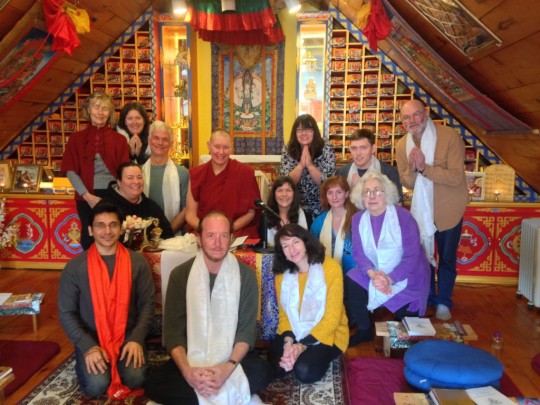
Ven. Tenzin Chogkyi led a three-day retreat on the bodhisattva vows, Milarepa Center, Vermont, January 2015. Photo courtesy of Milarepa Center.
“During the past few months Milarepa Center has had the honor of hosting an array of teachers that have benefited the Northeast Kingdom of Vermont in the United States greatly,” said office assistant Tommy Nimrod. “Geshe Konchog from Florida visited in November and held our concentration with the seven-point mind training. Members from Tubten Kunga Center, Geshe Konchog’s place of residence, flew in to attend a four-day Medicine Buddha retreat. Geshe-la’s last teaching left us with a unique representation of Mount Meru, using fruits from the kitchen.
“Transitioning into the holiday spirit, it was only appropriate for Ven. Tenzin Chogkyi to deck the halls with a Big Love day retreat. Ven. Chogkyi also led a beautiful five-day New Year’s Vajrasttava retreat. We ended the retreat by letting biodegradable lanterns, decorated with mantras and positive thoughts for the new year, into the crisp, winter night. In January, Ven. Chogkyi also led a three-day bodhisattva vows retreat which gave insight into the origination of the vows and how to implement them in daily life. She finished her teachings with a visit to the Kellogg Public Library in Montpeliar, the capital of Vermont, and spoke about dealing with emotions.
“At the end of January, director Felicity and kitchen manager Devon visited Land of Medicine Buddha for a delightful Foundation Service Seminar and the FPMT North American Regional Meeting. Felicity and Devon had a wonderful time learning more about the FPMT and exploring ways to keep a strong connection to Lama Yeshe and Lama Zopa Rinpoche. They loved connecting with the FPMT sangha from across the United States, Canada, and Mexico.
“In the upcoming Tibetan New Year we hope to continue to actualize the mission of FPMT in ‘creating a harmonious environment and helping all beings develop their full potential of infinite wisdom and compassion.’ We hope to see you at Milarepa Center soon for a personal or a group retreat. We are looking forward to serving you.”
Mandala brings you news of Lama Zopa Rinpoche and of activities, teachings and events from nearly 160 FPMT centers, projects and services around the globe. If you like what you read on Mandala, consider becoming a Friend of FPMT, which supports our work.
- Tagged: milarepa center
- 0
16
A New Era of Mandala Magazine
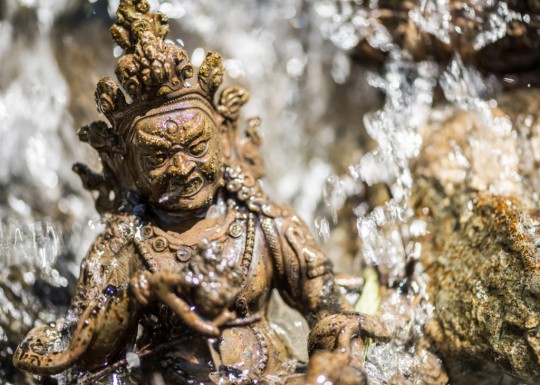
Detail of an outside fountain at Kachoe Dechen Ling, Aptos, California. Photo by Chris Majors.
Long gone are the days when we only received news of Lama Zopa Rinpoche and the FPMT organization through the mail. Between blog posts, Mandala’s expanded online features and social media like Facebook, engaged FPMT students around the world have countless photos and updates at their fingertips, shared sometimes as they happen. In response to this tremendous growth and availability of digital media, Mandala magazine is being reimagined.
Mandala has taken different forms over the three decades that it has been published. In June 2015, we unveil the newest, and we hope a very timeless and beautiful, version of Mandala!
The redesigned Mandala magazine will be published twice a year, in June and December, containing stories and teachings tailored to best make use of print media’s capacity for sharing quality, long-form pieces, thoughtful interviews and sharp, high-resolution photos. We are increasing the number of pages of each issue and updating the magazine’s design in order to create an enduring publication that students will want keep and read over again. We also will be publishing special Mandala ebooks, which will share some of the best stories from Mandala’s archive. Mandala’s first ebook will be available in September 2015.
In the July-December 2015 issue*, published June 16, 2015, readers can look forward to authentic and timeless teachings from Lama Zopa Rinpoche and Lama Yeshe, an in-depth feature on preparing for death, a profile of the profoundly compassionate Khunu Lama Rinpoche and much more.
To receive Mandala, become a Friend of FPMT supporter at the e-Friends level or higher. By joining Friends of FPMT, not only are you supporting the communications and education work of FPMT’s International Office, you receive Mandala magazine, Mandala’s new ebooks, and free access to Online Learning Center courses, FPMT Education practice and study materials and ebooks by Lama Zopa Rinpoche and Lama Yeshe. For more details and to join as a Friends supporter, see our Friends of FPMT page.
While you are waiting for the next issue, please take a look at Mandala’s expanded online publishing, which includes a new feature story every month. In this month’s feature, read the story of how FPMT student Tai Vautier helped develop FPMT’s microfilm mantras for filling prayer wheels, stupas and other holy objects. In case you missed March’s feature, “Bringing Dharma into the Corporate World,” Potential Project director Rasmus Hougaard talks with Mandala about how they are training corporate employees to be more kind and clear-minded with “Dharma in disguise.”
To receive daily emails from FPMT.org, digesting the day’s blog post, sign up on our news page. If daily email is too much, consider receiving the FPMT eNews, our monthly newsletter with updates from Lama Zopa Rinpoche, FPMT International Office and information on transitions and opportunities at the 160 FPMT centers, projects and services around the world.
*As part of our transition, we are forgoing the April-June 2015 issue.
Mandala brings you news of Lama Zopa Rinpoche and of activities, teachings and events from nearly 160 FPMT centers, projects and services around the globe. If you like what you read on Mandala, consider becoming a Friend of FPMT, which supports our work.
- Tagged: friends of fpmt, mandala, new mandala
- 0
13
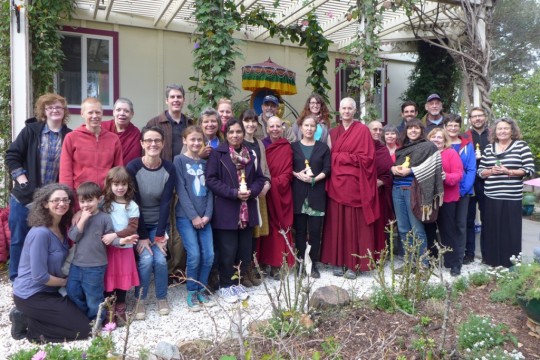
Foundation Service Seminar attendees during visit to Kachoe Dechen Ling, Aptos, California, January 2015. Photo by Laura Miller.
By Laura Miller, Mandala managing editor
In late January, I had the pleasure to be among the more than 40 people who attended the FPMT Foundation Service Seminar held at Land of Medicine Buddha (LMB) near Santa Cruz, California. The five-day seminar brought together staff and dedicated volunteers from several FPMT centers, projects and services in North America and Mexico. In addition to sessions focused on the worldwide efforts of FPMT, we spent time developing skills in speaking kind words, resolving conflicts, avoiding burnout and turning all aspects of working at a center into authentic Dharma practice. Ven. Drimay, a resident Sangha member at Land of Medicine Buddha, and Drolkar McCallum, coordinator for FPMT North America, skillfully facilitated the instructive sessions.
On one day, we had an afternoon field trip, which included an inspiring visit to Lama Zopa Rinpoche’s house, Kachoe Dechen Ling. After Ven. Holly Ansett led us on a tour of the house, many commented on how incredible and mind-blowing it was to see all the beautiful holy objects, altars and offerings throughout the house and gardens. Ven. Tsering, a Kopan monk who lives at the house and is writing out the Prajñaparamita Sutra in gold, showed us his beautiful work and talked about his process. And Ven. Anet baked delicious cakes that accompanied a relaxed tea break on the back deck. After leaving Rinpoche’s house, we watched a lovely sunset over the Pacific Ocean on a nearby beach and had an informal and friendly dinner at a local vegetarian restaurant.
Another highlight of the seminar was an evening of stories about FPMT founder Lama Yeshe. Robbie Solick, Jon Landaw and Karuna and Pam Cayton took turns sharing memories of some of Lama Yeshe’s incomparable qualities like kindness, humor and wisdom. The informal program of stories was more than a nostalgic walk down memory lane, it was a transmission of FPMT Wisdom Culture that palpably energized the room and the rest of the meeting.
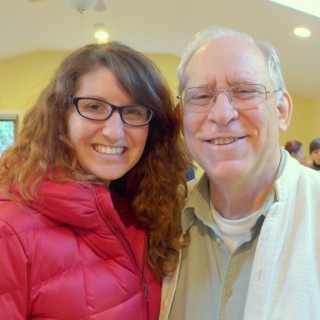
Felicity Keeley, director of Milarepa Center, with Jon Landaw, Land of Medicine Buddha, January 2015. Photo by Laura Miller.
Land of Medicine Buddha was a generous and accommodating host for the seminar and the FPMT North America Regional Meeting that followed. LMB director Denice Macy gave a tour of the center’s extensive grounds, which has many prayer wheels, incredible artwork and holy objects, and the amazing Mahabodhi Stupa that is being built.
The two-day FPMT North America Regional Meeting, which followed the seminar, was attended by 30 people, representing 17 centers, projects and services in the United States and Canada and one person from Mexico! FPMT Education Services director Tom Truty attended and led an engaged discussion on possible updates to the Discovering Buddhism program and other Education Services initiatives. Other agenda points included fundraising, good governance and updates from the 2014 CPMT meeting.
“I felt that the most significant and important thing accomplished at the Foundation Service Seminar and the FPMT North America Regional Meeting was a sense of community and the realization that all center, projects, services and study groups are facing very similar problems and challenges,” Drolkar McCallum told Mandala. “By coming together, supporting each other and sharing information and problem solving techniques we can inspire each other to continue our amazing work. Everyone came away from the seminar and meeting with a better understanding and sense of Rinpoche’s large mandala and the realization that we are not alone in our work, that there is a fabulous FPMT family to inspire us and a local regional group to help every step of the way. People left refreshed with renewed sense of purpose and armed with information and the enthusiasm to continue work for all sentient beings. Service is our practice!”
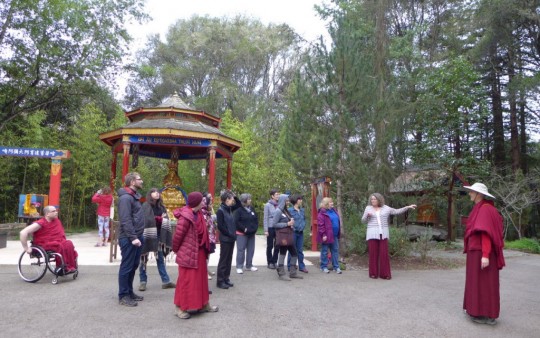
Denice Macy leads some Foundation Service Seminar participants on a tour of Land of Medicine Buddha, California, January 2015. Photo by Laura Miller.
Mandala brings you news of Lama Zopa Rinpoche and of activities, teachings and events from nearly 160 FPMT centers, projects and services around the globe. If you like what you read on Mandala, consider becoming a Friend of FPMT, which supports our work.
- Tagged: foundation service seminar, fpmt north america, kachoe dechen ling, land of medicine buddha
- 0
9
Update on Maitreya Buddha Kushinagar Project
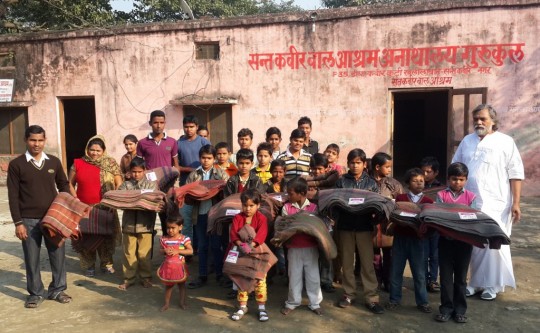
During the winter 2014 months, Maitreya Buddha Kunshinagar Project distributed thick blankets to various institutions, including orphanages, India, 2014. Photo courtesy of Maitreya Buddha Kushinagar Project.
The Maitreya Buddha Kushinagar Project, a project to build a very large statue of Maitreya Buddha in Kushinagar, India, continues to make steady progress.
In December 2013, the State Government of Uttar Pradesh commemorated the project with a Foundation Stone Laying Ceremony, attended by Lama Zopa Rinpoche and senior Uttar Pradesh officials.
The project is currently completing formalities with the state government. A key part of these was the submission by Maitreya Project Trust of a detailed project report. This was submitted to the government in February 2015. After what is hoped to be a final meeting, the Maitreya Buddha Kushinagar Project anticipates taking possession of 170 acres of land within a few weeks.
“170 acres is an enormous area,” long-time FPMT student Peter Kedge, who is involved with the project, told Mandala in February. “The land is adjacent to the Buddha Shakyamuni Paranirvana Temple and Shrine, and it borders on three sides the Ramabhar Stupa, the site of Buddha Shakyamuni’s cremation.”
Preliminary master planning of the site has begun, and the social work aspect of the project is already underway. Last year, a mobile health clinic was purchased, and it has traveled to local villages to provide primary healthcare education in aspects of primary health care and sanitation.
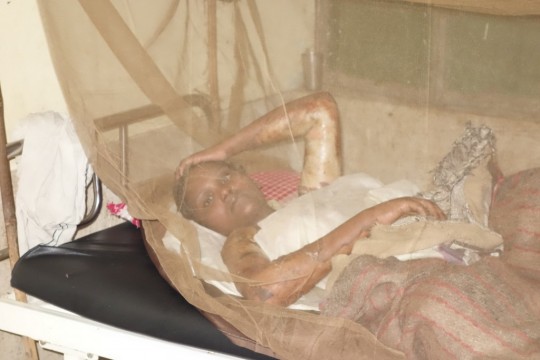
Mosquito nets donated by Maitreya Buddha Kushinagar Project help protect healing patients, India, 2014. Photo courtesy of Maitreya Buddha Kushinagar Project.
In the summer of 2014, mosquito nets and information on airborne disease control were distributed. In addition, during part of the winter, mosquito nets were being given to hospitals with burn wards to protect patients healing from burns. Burn accidents, especially among children, occur more often during cold months due to open fires in the home. The nets are set up around patients with open wounds to protect them from flies and mosquitos that may be in the hospital itself.
Over the recent winter months, the project distributed 2,400 high quality heavy wool blankets in three villages near the project, as well as to homeless people, street sleepers, beggars, a leper colony, orphanages, and widows homes. Many blankets were distributed to hospital patients and their families who have to stay in and around hospitals to care for their them.
Now that the weather is becoming warmer, the project plans to begin distributing mosquito nets again.
In 2014, Lama Zopa Rinpoche through the Lama Zopa Rinpoche Bodhichitta Fund offered US$16,000 towards the project’s social service work.
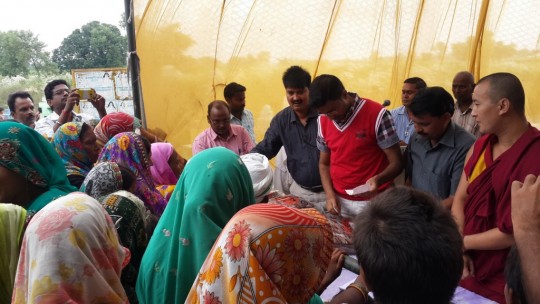
Maitreya Buddha Kushinagar Project workers distribute mosquito nets, India, 2014. Photo courtesy of Maitreya Buddha Kushinagar Project.
The project’s team is optimistic about their progress. According to Peter, there is a great team in India and there are plans to enlarge the team as soon as the project takes possession of the land as there will be a huge amount of work to do. Boundaries will have to be established and fenced; and on-site infrastructure, including roads, power, water, communications and facilities for a site office, and site security have to be set up.
There are plans to move the 24-foot [7-meter] Maitreya Buddha statue currently on the Maitreya Project Bodhgaya land to the land in Kushinagar. The installation of the statue will provide a temporary focal point for visitors, as well as a site for pujas, ceremonies, teaching, and meditation classes.
In India, generally people only acknowledge one Buddha – Shakyamuni Buddha. Maitreya Buddha is little known or acknowledged in Indian culture. It will be imperative for the project to establish a resonance with Indian culture by reflecting, acknowledging, and linking Shakyamuni Buddha’s life, teaching, and sacred parinirvana and cremation sites, with Maitreya, a disciple of Shakyamuni Buddha, the future buddha of our world, and the embodiment of loving kindness.
“It’s incredible!” Peter said, “Kushinagar is the place where both past and future buddhas meet,” noting that according to a text discovered by Lama Zopa Rinpoche, Kushinagar is not only the place of Buddha Shakyamuni’s passing into parinirvana, it is also the place where Maitreya Buddha will manifest.
Maitreya Buddha Kushinagar Project welcomes anyone to learn more about and support the project.
Mandala brings you news of Lama Zopa Rinpoche and of activities, teachings and events from nearly 160 FPMT centers, projects and services around the globe. If you like what you read on Mandala, consider becoming a Friend of FPMT, which supports our work.
6
Kadampa Center Helps Build an Interfaith Home
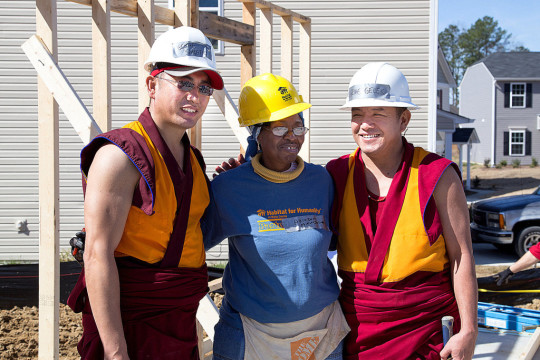
Geshe Sangpo and Geshe Gelek with future homeowner Abiodun Akinsola, North Carolina, US, March 2015. Photo by David Strevel.
Student Elise Strevel from Kadampa Center in Raleigh, North Carolina, in the United States recently sent Mandala news about the center’s interfaith work with the non-profit organization Habitat for Humanity:
Geshe Gelek Choda and Geshe Palden Sangpo, resident teachers for the Kadampa Center for the Practice of Tibetan Buddhism, kindly and happily participated in a Habitat for Humanity Interfaith Coalition Faith Leaders’ Wall Raising on March 12, 2015.
They represented the Buddhists from Kadampa Center, one of eight different faiths from 20 different faith communities, which also included Baha’i, Christianity, Hinduism, Judaism, Islam, Sikhism, and Unitarianism. The faith leaders came together to bless this first day of construction and to represent the support of their memberships.
The home is being built for Abiodun Akinsola and her sons, who are from Nigeria. Habitat for Humanity of Wake County empowers people who qualify to build and buy their own homes. To be chosen, the family must contribute 250 hours of “sweat equity” to the build, and be able to pay a modest down payment and monthly mortgage.
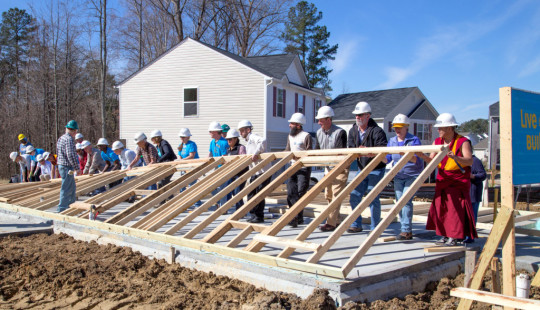
Twenty communities representing eight faith traditions worked together to raise the walls of the new home, North Carolina, US, March 2015. Photo by David Strevel.
Geshe Gelek and Geshe Sangpo are accustomed to hard work and had participated in lots of construction for their monastery in India. However, they had no experience with board and nail construction, which is the way this house is being built. They needed instruction on how to hammer in a nail and use the power saw and drill. They both learned very quickly and in less than an hour they were working like professionals! Others were impressed with their industriousness and careful work.
The construction of this home had special meaning because of the recent murder in North Carolina of three Muslim students – Deah Barakat, Yusor Abu Salha, and her sister Razan – who were volunteers with Habitat for Humanity. Plans were announced for another Habitat home that will be built in their honor in Wake County in May and one in their native land of Jordan.
Mandala brings you news of Lama Zopa Rinpoche and of activities, teachings and events from nearly 160 FPMT centers, projects and services around the globe. If you like what you read on Mandala, consider becoming a Friend of FPMT, which supports our work.
- Tagged: community service, interfaith, kadampa center
- 0
2
Moscow Prepares to Meet Lama Zopa Rinpoche
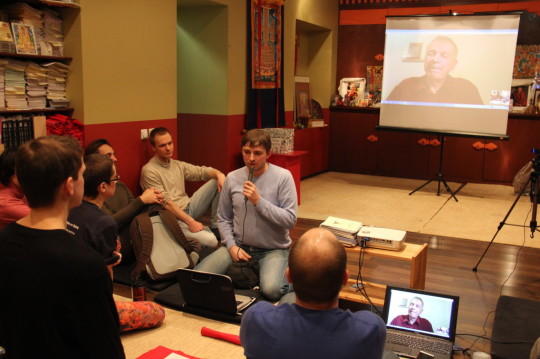
Students of Ganden Tendar Ling receive preparatory teachings from Andy Wistreich for Lama Zopa Rinpoche’s July visit, Moscow, Russia, February 2015. Photo courtesy of Ganden Tendar Ling.
Maxim Severin from Ganden Tendar Ling in Moscow shares with Mandala how the center is preparing for Lama Zopa Rinpoche’s July 2015 visit:
We would like to share the greatest news: Lama Zopa Rinpoche agreed to come to Moscow during July 1-5. He will give teachings on the three principal aspects of the path. Last time Rinpoche came to Moscow was back in 2003. We are overwhelmed with joy and happiness! Our preparations are in full swing and we aspire to arrange the visit the best we can so that Buddhists from all over Russia and other countries can come and benefit from the teachings.
We started a program called “Meeting Lama Zopa.” Andy Wistreich, a well-known British FPMT registered teacher gives lectures on how to relate to the spiritual teacher in an unusual format – via Skype! Basing his talks on the book The Heart of The Path by Rinpoche, Andy speaks with energy and with a very special warm humor about the importance and responsibility of choosing your guru; how to establish and maintain spiritual ties with him; and how to build respectful, caring and compassionate relations with people in a secular society. He tells us about his own relationship with Rinpoche.
We have translated the book The Heart of The Path into Russian and wish to publish it by his visit. Everybody wishing to help Russian speakers read this crucially important book is welcome to contribute to its publication.
Mandala brings you news of Lama Zopa Rinpoche and of activities, teachings and events from nearly 160 FPMT centers, projects and services around the globe. If you like what you read on Mandala, consider becoming a Friend of FPMT, which supports our work. For more on upcoming teaching events with Rinpoche, see Rinpoche’s schedule on FPMT.org.
- Tagged: ganden tendar ling, russia
- 0
27
Tenzin Ösel Hita Visits Losang Dragpa Centre in Malaysia During Losar
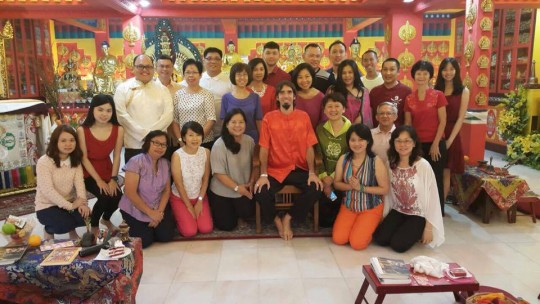
Ösel Hita with Losang Dragpa Centre students.
In February 2015, Losang Dragpa Centre, Malaysia, was pleased to welcome Tenzin Ösel Hita for Guru Puja on Losar, Tibetan New Year. Following the puja, Ösel gave an inspiring talk to the group. You can see a snippet of this talk below on the Lama Yeshe Wisdom Archive YouTube channel:
This year’s Losar marked 31 years since Lama Yeshe’s passing and Ösel’s visit was an auspicious and wonderful experience for all in attendance.
Mandala Publications will have more information on Ösel‘s talk and this visit in a forthcoming story.
The Big Love Fund supports Ösel‘s educational endeavors. You can follow news and updates about Ösel on the Ösel Hita news feed.
- Tagged: losang dragpa centre, tenzin osel hita
- 0
26
Family Camp 2014 at Milarepa Center
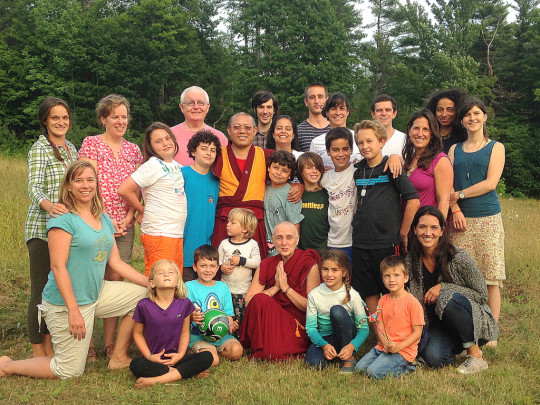
Geshe Tenley and Ven. Sarah Thresher with 2014 Milarepa Center Family Camp participants, Barnet, Vermont, US, August 2014. Photo by Felicity Keeley.
Kasia Beznoska, a long-time student and a mother, wanted FPMT students everywhere to know about the benefits of Buddhist-inspired family camps such as that of Milarepa Center in Barnet, Vermont, United States:
The weekend of July 31- August 3, 2014, was spent in the most fulfilling, joyful way at Milarepa Center in Barnet, Vermont, as families came together for Milarepa Center Family Camp. This year the camp theme was “Chenrezig & Compassion In Action.” Geshe Ngawang Tenley, resident teacher at Kurukulla Center in Medford, Massachusetts, came to camp again this year to lead discussions for parents and grandparents. Geshe-la was so wonderful with all of the children – playing soccer, painting and telling them stories about when he was younger in Tibet.

Families are able to enjoy quality time in a safe and loving space, Milarepa Center, Barnet, Vermont, US, August 2014. Photo by Felicity Keeley.
Each morning the children practiced yoga, helped fill water bowls, and came together in the gompa to make offerings and were guided in a short meditation by canp organizers Chessy Kelley and myself. The campers also participated in learning about archery and swordplay from local teacher Jack Stewart, who spoke about how moving slowly and focusing gave one greater control over one’s mind and body. Skip Cady taught circus acts and juggling, which everyone enjoyed greatly! Face painting, slip and slide, and tag were other favorites during camp this year. On the second evening of camp, Geshe-la and Ven. Sarah Thresher led all the families in an animal liberation, freeing hundreds of worms from the local store down the road that would otherwise have been used as fishing bait. The worms were circumambulated around Milarepa Center’s stupa many times while everyone chanted Chenrezig’s mantra – OM MANI PADME HUM – and then released into the ground.
Campers, parents, grandparents and staff at Milarepa Center all created an amazing Peace Pole to add to the garden at Milarepa Center this year as well. From the colors used to paint, to the words and pictures drawn, everything was made from a space of love and kindness. The children were told that this pole they helped to decorate would remain at Milarepa Center for all the visitors to see when they come and that their loving energy would be felt by all. They also painted rocks, and Geshe-la added Chenrezig mantras to the rocks and placed them around the pole. This was a really beautiful project for everyone to make together.
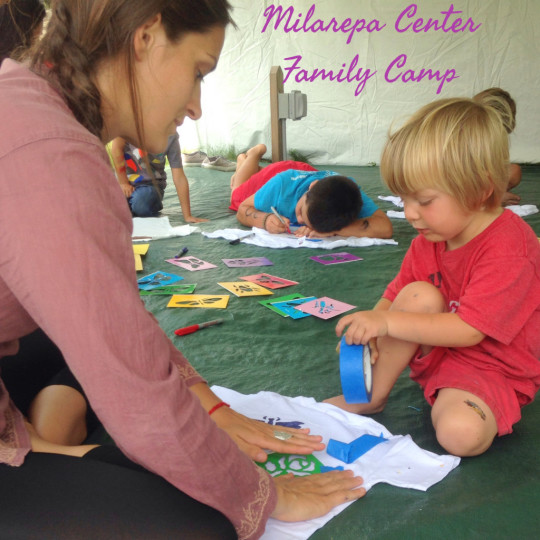
Art and creativity are regular features at Milarepa Center family camps, Barnet, Vermont, US, August 2014. Photo by Felicity Keeley.
Every year at camp on the last night there is a fire puja and talent show. This year campers sang songs, performed self-directed skits and enjoyed having some yummy camp fire treats. Everyone was greeted by the lovely Felicity Keeley, director of Milarepa Center, in her very fashionable costume, while she hosted the talent show that evening.
It was amazing to witness all the campers in a very free, loving environment, where they played together and worked though small conflict in considerate and patient ways. We had families travel from Florida, California, North Carolina, Massachusetts, New Hampshire and Vermont! Wow! Some families slept inside the center while others enjoyed camping outside in the nearby field.

Two new camp friends, Milarepa Center, Barnet, Vermont, US, August 2014. Photo by Felicity Keeley.
One of the most magical experiences of camp is when children can see their camp friends again. Some of these children only see each other once per year, but their friendship picks up right where it left off from the last summer. As they all grow and change, there is an everlasting current of love and friendship from the year before.
One moment that filled my heart with happiness occurred while watching two of the older boy campers, Lucas and Tre, during their swordplay instruction. They were matched against each other and had rules about where to tap the other player to get them out. Lucas tapped Tre first and got Tre out. As Tre began walking to sit down on the side, he gave Lucas a thumbs up and said “good job” to him. That doesn’t always happen these days while children are competing in sports or other activities. Another older camper, Perry, who has been coming to camp for the past few years, gave some of his popcorn to a younger camper without even being asked, because his younger friend didn’t have any. There is SO MUCH hope for the future, and it is heart-warming to know that peaceful learning is being taught and practiced by families all over.
Milarepa Center hopes that you and your family will consider joining them this summer for another incredible weekend at Family Camp. Registration is open now for 2015 Milarepa Center Family Camp.
Mandala brings you news of Lama Zopa Rinpoche and of activities, teachings and events from nearly 160 FPMT centers, projects and services around the globe. If you like what you read on Mandala, consider becoming a Friend of FPMT, which supports our work.
- Tagged: children, family, kasia beznoska, milarepa center
- 0
23
Happy Year of the Sheep from Animal Liberation Sanctuary!
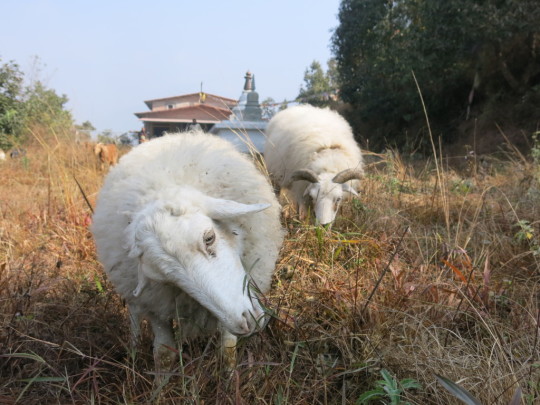
Resident sheep at Animal Liberation Sanctuary, Kopan, Nepal, January 2014. Photo courtesy of Phil Hunt.
Co-director Phil Hunt of Enlightenment for the Dear Animals provides a brief update on the Animal Liberation Sanctuary, a refuge for animals near Kopan Monastery, FPMT’s mother monastery in Nepal.
The Animal Liberation Sanctuary (ALS), Nepal, has had its first anniversary on its new land and it seems somehow appropriate that it coincides with the year of the sheep!
After the move to the land in January 2014, the last year has been one of settling into the new facilities, finalizing unfinished building works and establishing new procedures. The sanctuary is quite different from the animals’ previous home. The floors where animals sleep are earth, rather than concrete, which is more gentle on their joints; the floor is covered in a deep bedding of straw which provides comfort as well as hygiene and insulation; the large shelter has stalls where not-so-mobile or quieter animals can sleep without the worry of being pushed about at night; there is a quarantine area including an isolation room for contagious diseases with separate outdoor grazing area; and a treatment room for operations has been built, although still lacking in much equipment, so the animals do not have to make the stressful journey into Kathmandu.
The land has no permanent road access and the foot track has been partially closed due to neighboring development. However, we have been pleased to welcome some hardy visitors who made the journey, including Amitabha Buddhist Centre student and model Nadya Hutagalung; pilgrims from Vajrayana Institute, Sydney; students from Lincoln School, Kathmandu; and two large groups of retreatants from the 2014 November course with Kopan’s Geshe Jinpa.
Sadly, this year there have been several injured young male calves left at the Kopan Nunnery gates. As males do not produce milk, they are unwanted. In Nepal they are put out on the street to fend for themselves. (In the West, this “surplus” from the dairy industry is usually sold to veal farms.) Being separated from their mothers, these unwanted babies are usually depressed, malnourished, and sometimes wounded. The latest, Kalden, was suffering from major infected wounds to his back legs from dog attacks. Fortunately, he is getting better every day under the care of ALS staff.
There are still many challenges ahead as we try to balance the needs of 50 animals on a relatively small piece of land. Three of our much loved older residents died towards the end of last year: Dawa the three-legged sheep; Jigme the goat; as well as Nyingje who had been struggling with a chronic condition for the last two years. We hope their exposure to holy objects and Dharma will bring them a quick escape from the lower realms and samsara. After all, this is the real purpose of the Animal Liberation Sanctuary.
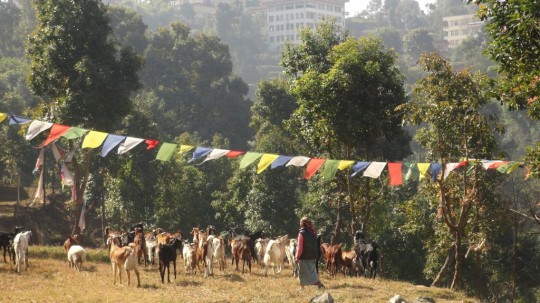
Animal Liberation Sanctuary goats, Kopan, Nepal, January 2014. Photo courtesy of Phil Hunt.
Mandala brings you news of Lama Zopa Rinpoche and of activities, teachings and events from nearly 160 FPMT centers, projects and services around the globe. If you like what you read on Mandala, consider becoming a Friend of FPMT, which supports our work.
- Tagged: animal liberation sanctuary, animals, phil hunt
- 0
19
News from Nagarjuna C.E.T. Granada, Spain
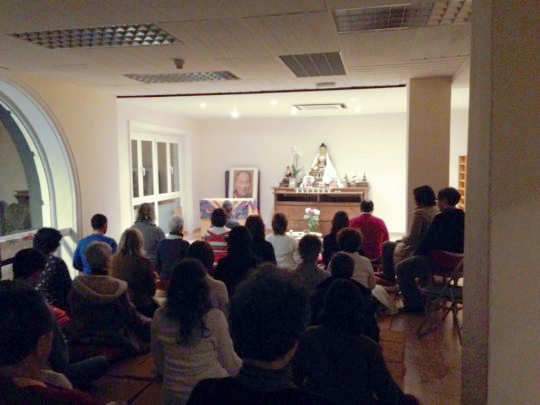
Minutes after Nagarjuna C.E.T. Granada students moved into their new center, everyone did a short meditation on Shakyamuni Buddha, Granada, Spain, February 2015. Photo courtesy of Nagarjuna C.E.T. Granada.
Spiritual program coordinator Antonio Jabaloy Sánchez shared some brief news about Nagarjuna C.E.T. Granada in Spain:
Here in Nagarjuna C. E. T. Granada, we are having a busy time. We have rented a commercial office in the historic center of Granada, something like a commercial loft, and now we have worked on remodeling projects: masonry and the painting. Most of the work has been done by a little group of enthusiastic volunteers. Moving day was on February 16. We did a lot of work and we finished with tea and a small meditation on Shakyamuni Buddha.
We have just celebrated Losar and the anniversary of the death of Lama Yeshe. All the work was done without stopping our regular courses and meditation classes.
Mandala brings you news of Lama Zopa Rinpoche and of activities, teachings and events from nearly 160 FPMT centers, projects and services around the globe. If you like what you read on Mandala, consider becoming a Friend of FPMT, which supports our work.
- Tagged: nagarjuna c.e.t. granada, spain
- 0
16
The Golden Light Sutra and the Wasp Nest
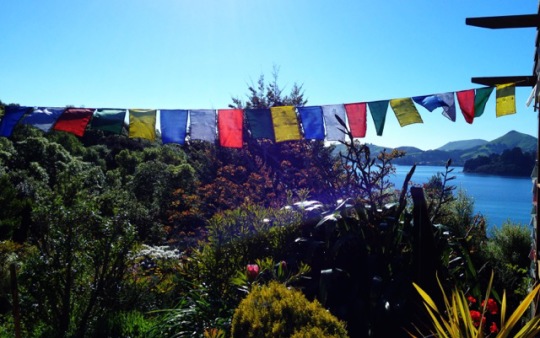
Martine Darrou’s garden in Dunedin, New Zealand
“Today while clearing a part of the yard, I stumbled upon a wasp nest and suddenly was enveloped by a swarm of angry wasps!” said student Martine Darrou from Dunedin, New Zealand. “Trying to remain calm, I suddenly recalled our precious Lama Zopa Rinpoche’s advice about the Golden Light Sutra during the Bendigo teachings and, almost instantly, the cone of the wasps opened and I could move out of it.
“I quickly went insight to get my text and going back to wasp still buzzing, I read out loud chapter 19 ‘On the Praise of All the Tathagatas.’ Again, the wasps quieted down and they peacefully went back to their nest. It’s amazing I wasn’t stung at all!
“After, I thought how fortunate I was not to have been stung and how kind and compassionate Rinpoche is to give us such a precious tool to help us and all sentient beings and also how powerful the sutra is. Thank you so much for the hard work and dedication of all to make the sutra available.”
Recitation of the Golden Light Sutra is one of Lama Zopa Rinpoche’s Vast Visions for FPMT. FPMT Education Services has created a resource page to help you learn more about and start reciting the Golden Light Sutra.
Mandala brings you news of Lama Zopa Rinpoche and of activities, teachings and events from nearly 160 FPMT centers, projects and services around the globe. If you like what you read on Mandala, consider becoming a Friend of FPMT, which supports our work.
- Tagged: golden light sutra
- 0
12
2.5 Million Mantras and One Statue for Peace in Spain
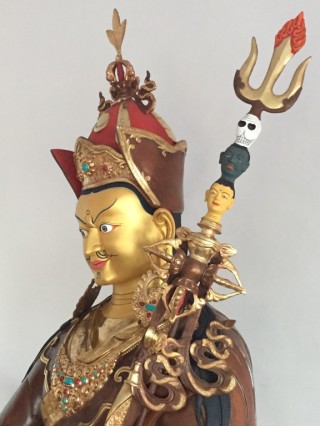
Padmasambhava statue at O.Sel.Ling, Orgiva, Spain, 2015.
Anne Wenaas, director of O.Sel.Ling Centro de Retiros in Spain, shared the center’s recent amazing practice accomplishments:
On Christmas 2015, we started a one-week mani retreat. Ven. Yeshe Chodron started to lead it and then Irina, a volunteer here, continued with the responsibility. We asked everyone in Spain [there are 11 centers, projects and services in the country] to join us. We finished accumulating recitations of the OM MANI PADME HUM mantra on February 15.
We all dedicated the 2,691,696 million mantras towards the long life of His Holiness, Lama Zopa Rinpoche, and all our gurus. Most especially, we dedicated that all of Rinpoche’s holy projects be quickly fulfilled!
The idea is to organize the same thing next year, but allowing for more time for the accumulation and offering more information to participants. We thought to explore the idea of offering free one-week retreats at O.Sel.Ling to give the accumulation an energetic start and then continue for some months. Also, we’re thinking to make Saturday a time when everyone interested could come up to the hill to do a one-day accumulation retreat together.
On February 2, we finished filling the new 2-meter [6-foot] Padmasambhava statue with the help of Ven. Thubten from Nalanda Monastery in France. We’re so happy to join Rinpoche’s vast vision of having many, many of these statues around the world for peace on earth and for Tibet to be free! [You can learn more about this specific vast vision on the Padmasambhava Project for Peace page.]
The statue will sit in a new gompa in our new reception area that is especially designed for tourists and visitors. We’ll make it the end of a pilgrimage-tour for all visitors and this will help keep the rest of the property more secluded for retreatants.
Mandala brings you news of Lama Zopa Rinpoche and of activities, teachings and events from nearly 160 FPMT centers, projects and services around the globe. If you like what you read on Mandala, consider becoming a Friend of FPMT, which supports our work.
- Tagged: o.sel.ling, padmasambhava project for peace
- 0
- Home
- News/Media
- Study & Practice
- About FPMT Education Services
- Latest News
- Programs
- New to Buddhism?
- Buddhist Mind Science: Activating Your Potential
- Heart Advice for Death and Dying
- Discovering Buddhism
- Living in the Path
- Exploring Buddhism
- FPMT Basic Program
- FPMT Masters Program
- FPMT In-Depth Meditation Training
- Maitripa College
- Lotsawa Rinchen Zangpo Translator Program
- Universal Education for Compassion & Wisdom
- Online Learning Center
- Prayers & Practice Materials
- Overview of Prayers & Practices
- Full Catalogue of Prayers & Practice Materials
- Explore Popular Topics
- Benefiting Animals
- Chenrezig Resources
- Death & Dying Resources
- Lama Chopa (Guru Puja)
- Lama Zopa Rinpoche: Compendium of Precious Instructions
- Lama Zopa Rinpoche: Life Practice Advice
- Lama Zopa Rinpoche Practice Series
- Lamrim Resources
- Mantras
- Prayer Book Updates
- Purification Practices
- Sutras
- Thought Transformation (Lojong)
- Audio Materials
- Dharma Dates – Tibetan Calendar
- Translation Services
- Publishing Services
- Teachings and Advice
- Find Teachings and Advice
- Lama Zopa Rinpoche Advice Page
- Lama Zopa Rinpoche: Compendium of Precious Instructions
- Lama Zopa Rinpoche Video Teachings
- ༧སྐྱབས་རྗེ་བཟོད་པ་རིན་པོ་ཆེ་མཆོག་ནས་སྩལ་བའི་བཀའ་སློབ་བརྙན་འཕྲིན།
- Podcasts
- Lama Yeshe Wisdom Archive
- Buddhism FAQ
- Dharma for Young People
- Resources on Holy Objects
- Ways to Offer Support
- Centers
- Affiliates Area
- Teachers
- Projects
- Charitable Projects
- Make a Donation
- Applying for Grants
- News about Projects
- Other Projects within FPMT
- Support International Office
- Projects Photo Galleries
- Give Where Most Needed
- FPMT
- Shop
Subscribe to FPMT News
Translate*
*powered by Google TranslateTranslation of pages on fpmt.org is performed by Google Translate, a third party service which FPMT has no control over. The service provides automated computer translations that are only an approximation of the websites' original content. The translations should not be considered exact and only used as a rough guide.Most of the time our grasping at and craving for worldly pleasure does not give us satisfaction. It leads to more dissatisfaction and to psychologically crazier reactions.







